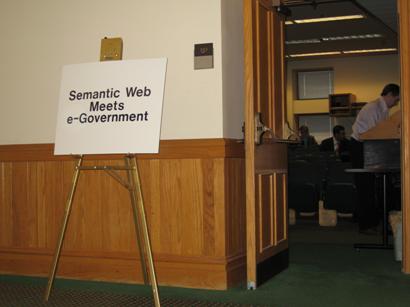




|
The Semantic Web meets eGovernment |
|
2006 AAAI Spring Symposium Series Stanford University, California, USA, March 27-29, 2006 |
|
Welcome to the website of the First International Symposium on the Semantic Web and eGovernment. website. |
|
We thank all participants in the SWEG Symposium for making it a success!
As discussed at Stanford, we will try to keep up the momentum and move on with further related activities (a portal, publications and a new event in 2007). The presentations and photos are available at the Program section of the site (we will also put the papers online shortly). If you want to receive updates send an e-mail to gmentzas@mail.ntua.gr. Thanks again to all of you! All participants should have received registration and hotel information from the AAAI conference organisers. Registration was closed February 10, 2006 (registration is also available at: http://www.aaai.org/Symposia/Spring/sss06.php). Some info about hotels is available also at the Location section of our site. Accepted papers and their authors are listed in the submissions section. We would like to thank the academics and practitioners (more than 60 people from 16 countries) who submitted a paper to the SWEG Symposium, as well as the reviewers (25 people from 10 countries) who supported us in the review process! Motivation for the Symposium The Semantic Web (SW) has been in the focus of the AI community for the last five years. However, after years of intensive research and impressive scientific results, what the SW now really needs is real-world use cases, in order to demonstrate its added (business) value. Moreover, the full application potential of some SW technologies, like Semantic Web Services and Rules has been neglected due to lack of large-scale testing domains. Finally, the next application-driven research challenges for SW can be defined only through the feedback from real use-cases. Therefore, the SW requires a large, dynamic, heterogeneous and shared information space to be effectively evaluated. On the other hand, the domain of e-Government is unique because of its enormous challenge to achieve interoperability, given the manifold semantic differences of interpretation of, e.g., law, regulations, citizen services, administrative processes, best-practices, and, last, but not least, the many different languages to be taken into account within and across regions, nations and continents. These semantic differences are related to a great variety of IT solutions (on local, regional, inter-/national level) which will have to be networked (despite any effort of standardisation). In consequence, some of the key obstacles for networked computer applications in governmental processes and services are those kinds of barriers in which the different meanings of data objects and interfaces cannot be automatically mediated. Setting up seamless e-government services requires information integration as well as process integration involving a variety of objects with specific semantics. Therefore, the combination of these two domains seems to be quite natural: the e-Government domain can provide an ideal test bed for existing SW research, and SW technologies can be an ideal platform to achieve the vision of a knowledge-based, user-centric, distributed and networked e-Government. Moreover, due to its open architecture, e-Government provides a palette of new research questions for SW, like interportal search (e.g. searching for additional resources on other portals to reply to a primary user or agent request). e-Government further exhibits some remarkable characteristics which make it more demanding, but also more promising, than common e-Business scenarios; to mention but a few such characteristics: · high degree of formality of key areas (law); · extreme requirements to come to same decisions in similar situations; · high demands with regard to security, privacy, and trust; · sometimes extremely long-running process instances (e.g. in urban and regional planning); · sometimes extreme information imbalances between stakeholders; · many different stakeholders in the same process (e.g., citizen vs. city council, county council, federal government) · and many more. |

|
The Semantic Web meets eGovernment |

|
Co-chairs of the Symposium: |
